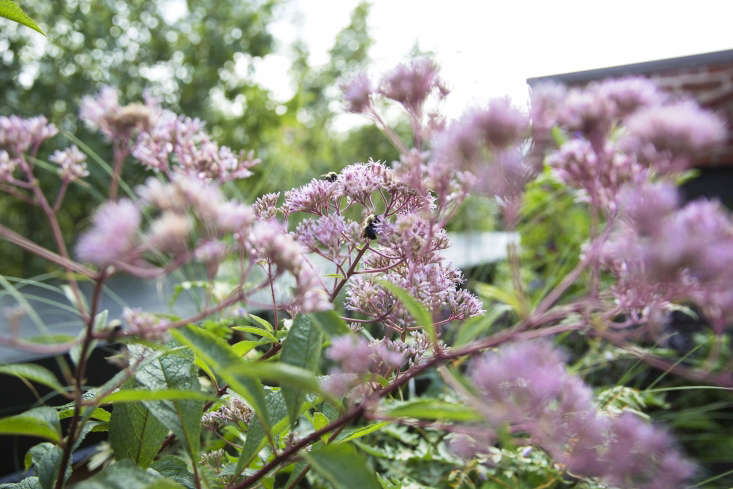When developers were renovating a landmarked Greek Revival–style townhouse in New York City’s Brooklyn Heights a few years ago, they called in talented florist Emily Thompson to design the gardens. Thompson, who does the flowers for the restaurant at Manhattan’s Museum of Modern Art (and once had a stint at the Obama White House as well), often works with native plants and tends to prefer texture over bloom.
Until 2014, the townhouse was owned by the Franciscan Sisters of the Poor and served as a home for nuns. The developers tore out the interior to create a six-bedroom single-family dwelling, and gave Thompson free rein to design the gardens including a roof garden, a backyard garden, and planters on the front stoop. See the results:
Photography by Mia Kim.
Brooklyn Roof Garden

“The brief was to bring it all to life,” says Thompson. “We wanted to keep it very simple, and make the space feel inhabited.”

“The terrace planters came out just the way I wanted them,” says Thompson. “Typically one might not plant grasses with vines, because their water and light needs can be quite different. But in this case the vines did exactly what I wanted—they wound their way through all the verticals like snakes in the grass.” The grasses, panicum ruby ribbons, have a purple stripe that repeats the plummy color palette. “They get big and full, which is nice in the fall when other plants die back.”

One nightshade variety, Solanum wenlandii, is the purple flowering vine in the middle towards the back. The leaves resemble those of pepper plants because nightshades are part of the same family, as are eggplants. And though they don’t winter over well in the northeast, Thompson says that “nightshades are so vigorous I’m happy to replant them year after year.”
The spiky-leafed vine at left is another variety of nightshade, Solanum pyracanthum, which sometimes blooms and bears fruit. The bright green vine at lower left is Akebia trifoliate.
Adding height and more color are two varieties of Joy Pye weed: one with pink bloom, at left (Eupatorium ‘maculatum’), and another with dark foliage (Eupatorium ‘rugosum’).

The solanum shows its blue flowers, and the buddleia at top right—known as the butterfly bush for its ability to attract those creatures—is bright with fuchsia-colored bloom. White flowers have sprung up on the Eupatorium ‘rugosum’ variety of Joe Pye weed, with dark foliage, also called snakeroot. The star-shaped speckled-purple flowers belong to the toad lily, Tricyrtus ’empress.’ While this plant prefers dappled shade, Thompson points out that it’s doing fine in this sunny spot thanks to the shade provided by taller plants.

“We’re in the path of the monarch butterfly migration here, so every time I do a garden I try to send some love their way,” says Thompson. In general, she feels that native plants that speak to the landscape of the region are an important part of any garden. “And what better way to experience a terrace than by having it come to life with birds and bees and monarchs and all the things that create an ecosystem?” she says.

In this area Thompson used white planters to add variety, and put in more Joe Pye weed and grasses to overfill the pots in a vertical sense, and to interact with the tops of the oak trees visible beyond. The coneflowers seen here are Echinacea ‘Hot Papaya.’
Brooklyn Front Stoop


Brooklyn Backyard Garden

Thompson sowed grass seed in between the pavers. Under the spring-blooming styrax tree are Tiarella (foamflower) and Heuchera (coral bells), prized for their foliage more than their bloom.


The six-story, six-bedroom house also has a front garden, a balcony off the kitchen, and a roof deck with views of lower Manhattan (not shown in these photographs). At the moment, the townhouse is still on the market—asking price $12.5 million. Interested? See the listing here.
See more outer-borough inspiration:
- Curb Appeal: 11 Front Garden Ideas to Steal from Brooklyn.
- Before & After: A Modern Townhouse Garden in Brooklyn.
- Rehab Diary: A Year in the Life of a Brooklyn Garden.
- My Brooklyn Story: Creating a Garden from Scratch in Crown Heights.












Have a Question or Comment About This Post?
Join the conversation (0)